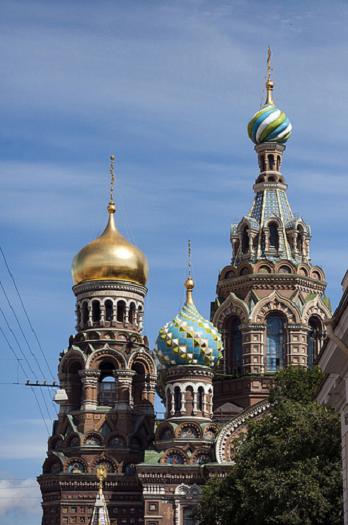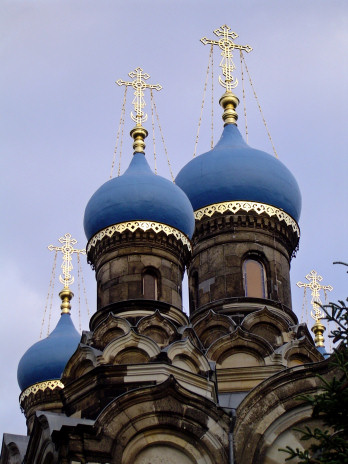On the Trail of the Onion
 Speaking of cathedrals (TAT#26), you won’t travel very far in this land without running into the ubiquitous “onion dome”. You’ve got to love ’em. Postcard Russia, as seen the world over. Curiously, there is still some debate as to the origins of this striking design feature. This was brought home to me when a close friend asked how they were built and where the style came from. It’s a paradox that something so blatant, conspicuous and distinctive should have origins that are so… vague. These onion domes’ presence is a shout, their genesis: a whisper…
Speaking of cathedrals (TAT#26), you won’t travel very far in this land without running into the ubiquitous “onion dome”. You’ve got to love ’em. Postcard Russia, as seen the world over. Curiously, there is still some debate as to the origins of this striking design feature. This was brought home to me when a close friend asked how they were built and where the style came from. It’s a paradox that something so blatant, conspicuous and distinctive should have origins that are so… vague. These onion domes’ presence is a shout, their genesis: a whisper…
Anyway, after a little mental cross-referencing and extrapolation, I realised that I didn’t have anything particularly solid to offer my friend by way of reply. An evolution of the Byzantine style, perhaps? Some hybrid that came about when this style was cross-bred with medieval Russian architecture? Time to poke around and see what can be unearthed.
Reportedly, the Russian onion dome was first utilised in the reconstruction of the Saint Sophia Cathedral in Novgorod, finished in 1050 (approx.). Why did Vladimir of Novgorod order a serving of onion domes, or at least green-light their construction? Well, in spite of my research efforts, I still don’t know. I was hoping to find, say, a decisive entry in a chronology where Vladimir saw an example of them somewhere and said: “I wouldn’t mind some of those myself, for this Cathedral I’m rebuilding”. But, sadly, no. It doesn’t help that some of Vladimir’s history has been actively suppressed, apparently, in order to undermine the claims of his heirs to Kiev…but that’s getting into another story.
There is conjecture about a Muslim or oriental inspiration, a reference to the Dome of the Rock (which isn’t onion-shaped) or that Byzantine hybrid again… This latter idea does seem to ring true in some way. If you take a look at images of Byzantine cathedrals, there’s definitely a similarity of form: a tendency towards squat, square-bodied piles attended by similar grouped sub-structures, all surmounted with single domes of various sizes (though hemispherical rather than onion-shaped). Reinforcing this connection are the Byzantine origins – via Constantine the Great and the Eastern Roman Empire – of the Russian Orthodox Church.
So, imagine the Byzantine style with a Russian twist. However, what exactly that twist and its origins would be…are a little unclear. Vladimir of Kiev introduced Christian Orthodoxy into Russia (or “Kievan Rus’”, as Nikolai Karamzin referred to the state of this era) after discovering it courtesy of the Byzantine Empire in 987 AD and subsequently being baptised in the faith. The problem when it comes to ascertaining what authentically Russian style the imported one may have merged with, is that no architecture pre-dating this time has survived! It was all to be conquered, re-conquered, rebuilt, pulled down – or to collapse of its own accord. Medieval Russia could be a dangerous place to live.
I’ve seen references to the classic Russian gable-end, which does in fact resemble an onion dome in profile. But which came first? The form is said to prevent snow from building up (potentially disastrously) on traditional wooden roofs, which could certainly suggest Russian origins, with the country’s protracted winters… Curious.
Anyway: whatever their inception, the onion domes’ popularity increased. There is pictorial evidence of their growth: imagery from the 13th century, well prior to their “resurgence” in the 15th and 16th centuries. This period spanned the reigns of Ivan III, Vasili III and Ivan IV (Ivan the Terrible) – as Russia’s stature and sociological structure grew and modernised.
 For such a distinctive form, it is not surprising that there is a degree of associated symbolism. Whether the domes were originally constructed as symbols, or whether they came to be symbolic and were actively utilised as such in the language of subsequent architecture, is unclear – to me at least. There are references to the onion-domed tower symbolising a burning candle: a powerful and enduring Christian symbol. Numerically, one tower represents Christ; three, the Holy Trinity; five, Christ and the Four Evangelists; and thirteen, Christ and the twelve Apostles (apparently, twenty-five represents the same, but with twelve Old Testament prophets thrown in).
For such a distinctive form, it is not surprising that there is a degree of associated symbolism. Whether the domes were originally constructed as symbols, or whether they came to be symbolic and were actively utilised as such in the language of subsequent architecture, is unclear – to me at least. There are references to the onion-domed tower symbolising a burning candle: a powerful and enduring Christian symbol. Numerically, one tower represents Christ; three, the Holy Trinity; five, Christ and the Four Evangelists; and thirteen, Christ and the twelve Apostles (apparently, twenty-five represents the same, but with twelve Old Testament prophets thrown in).
In terms of colour: gold is associated with Jesus; green, with the Holy Trinity; blue, with the Holy Spirit; and silver symbolises a dedication to a saint. There seems to be some variation here: a blue dome with a star is symbolic of the Virgin Mary and the Star of the Nativity, and green can also have a saintly connection. I’m sure there’s real I-SPY book potential here, as yet untapped…
Oh yes: the domes themselves are usually fabricated from tiles or sheet iron attached to a wood or metal frame. Just in case you were wondering.
Next time: Trips and Tales (Part 27)
Continuing the roundup of Moscow cathedrals, with the Cathedral of Christ the Saviour and Saint Basil’s Cathedral.[Photos by C. G. P. Grey and Ronald Schuster]


